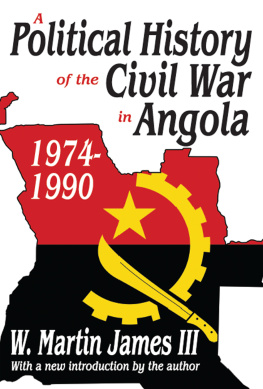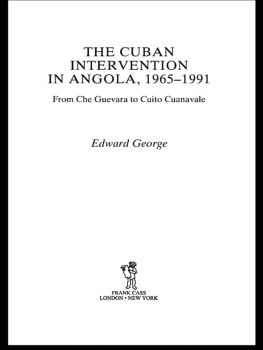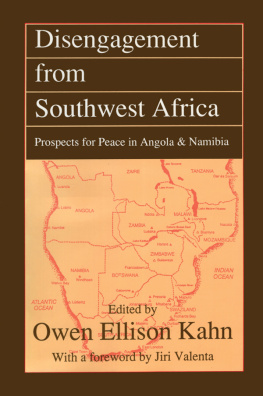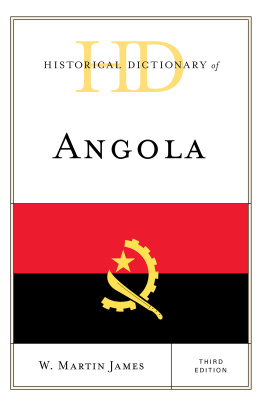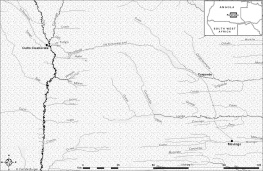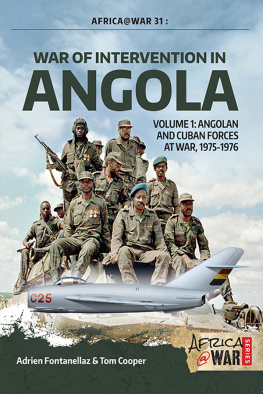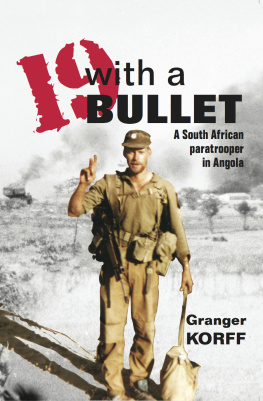First published 1992 by Transaction Publishers
Published 2017 by Routledge
2 Park Square, Milton Park, Abingdon, Oxon OX14 4RN
711 Third Avenue, New York, NY 10017, USA
Routledge is an imprint of the Taylor & Francis Group, an informa business
New material in this edition copyright 2011.
Copyright 1992 by Taylor & Francis.
All rights reserved. No part of this book may be reprinted or reproduced or utilised in any form or by any electronic, mechanical, or other means, now known or hereafter invented, including photocopying and recording, or in any information storage or retrieval system, without permission in writing from the publishers.
Notice:
Product or corporate names may be trademarks or registered trademarks, and are used only for identification and explanation without intent to infringe.
Library of Congress Catalog Number: 2010051379
Library of Congress Cataloging-in-Publication Data
James, W. Martin.
A political history of the civil war in Angola, 1974-1990 / W. Martin James III. -- Pbk. ed.
p. cm.
With a new foreword.
ISBN 978-1-4128-1506-2 (pbk.)
1. Angola--Politics and government--1975- 2. Unico Nacional para a Independjncia Total de Angola. 3. United States--Relations--Angola. 4. Angola--Relations--United States. 5. Soviet Union--Relations--Angola. 6. Angola--Relations--Soviet Union. I. Title.
DT1428.J36 2011
967.3042--dc22
2010051379
ISBN 13: 978-1-4128-1506-2 (pbk)
When A Political History of the Civil War in Angola, 19741990 was submitted to the publisher in 1990, the Unio Nacional para a Independncia Total de Angola (National Union for the Total Independence of Angola UNITA) was on the verge of victory, or at least being in a position to negotiate from strength, against the governing Movimento Popular de Libertao de Angola (Popular Movement for the Liberation of Angola MPLA).
Under pressure from the United States, the Soviet Union, and Portugal, the two warring factions agreed to the Bicesse Accords on May 31, 1991. The accords called for an immediate ceasefire, cantonment of both armies, creation of a new national army, and free, fair elections in September 1992. The United Nations (UN) was charged with the voter registration and conducting the elections. Problems arose immediately. The MPLA electorate was based mostly in Luanda (Angolas capital), making its voter registration easy. However, UNITAs supporters were mostly rural dwellers. The civil war had destroyed most roads, landmines had been planted extensively, and the United Nations allocated only $200 million and 400 monitors and civilian police in a nation the size of California and Texas combined. By contrast in Namibia, in 1989, the UN had sent 1,700 monitors at a cost of $373 million.
UNITA complained that its voters were not being registered. Despite complaints from the United States, the UN, churches, non-governmental organizations (NGOs), and the other political parties, the MPLA unilaterally ended the registration process on August 10, 1992. Eleven candidates ran for president, but the two most important were UNITAs Jonas Savimbi and Jos Eduardo dos Santos of the MPLA. The parliamentary elections were easily won by the MPLA, but in the presidential race dos Santo won 49.6 percent of the vote with Savimbi at 40.1 percent. The government-controlled media began announcing an MPLA victory soon after polls closed. UNITA and other parties complained about lack of transparency and fraud. The elections were generally free and fair, however, fraud occurred in the tabulation process. Ten political parties, but not UNITA, issued a declaration denouncing the election on October 2. Under electoral law victory could be achieved only by winning 50 percent plus one. Thus, a run-off election between the two top candidates was mandated. Despite misgivings, UNITA negotiators returned to Luanda to conduct negotiations for the run-off contest.
On October 31, 1992, the MPLA conducted a pogrom against the UNITA leadership and supporters in Luanda and surrounding areas. According to church sources, over 20,000 people were killed over the weekend. In an incident described as the Halloween Massacre, UNITAs vice-president, chief negotiator, and party secretary were killed. The government termed the weekend events as an attempted coup dtat by UNITA. Most accounts support the government version of events. Under the terms of the Bicesse Accords, UNITA was allowed 600 soldiers in Luanda to protect the partys leadership. It seems strange that one of the best guerrilla armies would attempt a military coup, in the stronghold of the MPLA, with only 600 lightly armed troops.
Regardless of the truth, the events led to a resumption of the civil war. In the cantonment camps, UNITA maintained military discipline, while the MPLA troops were unpaid, underfed, ill-equipped, and unmotivated. As a result, UNITA emerged from the camps combat ready. UNITA forces quickly captured five provincial capitals and laid siege to others. As the recognized government of Angola, the MPLA could purchase weapons to revamp the army and, in some instances, hire mercenaries to fight on behalf of the government. UNITA was forced to buy on the black market, resulting in rip-offs, time delays, and shoddy materiel. By July 1994, government forces had recaptured important cities and were placing enormous military pressure on UNITA.
The rebels sought to enter into a ceasefire with the government. Again, under pressure from the UN, the United States, and Portugal, the MPLA agreed to a ceasefire that called for the cantonment of the UNITA army. Also, the rebels would take their place as the loyal political opposition in Luanda, and would surrender occupied areas. The agreement, titled the Lusaka Protocol, was signed on November 20, 1994. Ominously, UNITAs leader, Savimbi, did not sign the document. The ceasefire held. UNITA did send some representatives to the capital city, but the rebels were reluctant to surrender many of the areas under their controlparticularly the areas near Andulo and Bailundo.
On March 13, 1996, UNITA celebrated the thirtieth anniversary of the formation of the party. As a guest, the author attended events in Bailundo and had the opportunity to interview several guerrilla generals: including Antnio Dembo, Altino Bock Sapalalo, and Arlindo Chinda Ben Ben Pena. To a man they believed UNITA could have militarily won the civil war in 1990. The rebels would have seized the countryside and laid siege to provincial capitals, forcing the government to capitulate. Luanda would slowly be encircled, preventing supplies from arriving by air or by sea. The rebel generals believed the United States had forced UNITA to accept the Bicesse Accords, allowing the MPLA to remain in power.
While fulfilling most of the Lusaka Protocol, the rebels were hesitant and slow to return towns and municipalities. Finally, in December 1998, at the MPLA IV Party Congress, President dos Santos was quoted as saying, The only way to attain definitive peace today is to isolate Dr. Savimbi and his warmongering wing domestically, and internationally, as well as to neutralize him politically and militarily. UNITA viewed the statement as a declaration of war. In January 1999, the government ordered the UN to leave the country, thus opening the way for a return to hostilities. The rebels started rapidly but soon government forces captured long-held UNITA areas, such Bailundo and Andulo in October 1999, and Jamba the next month. Savimbi announced in June 2001 that the rebels would return to guerrilla warfare.

